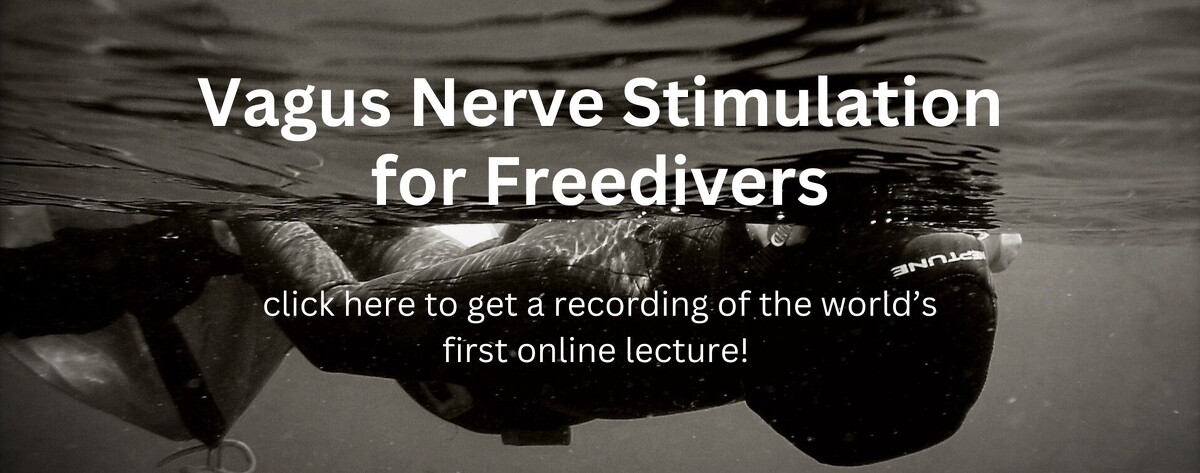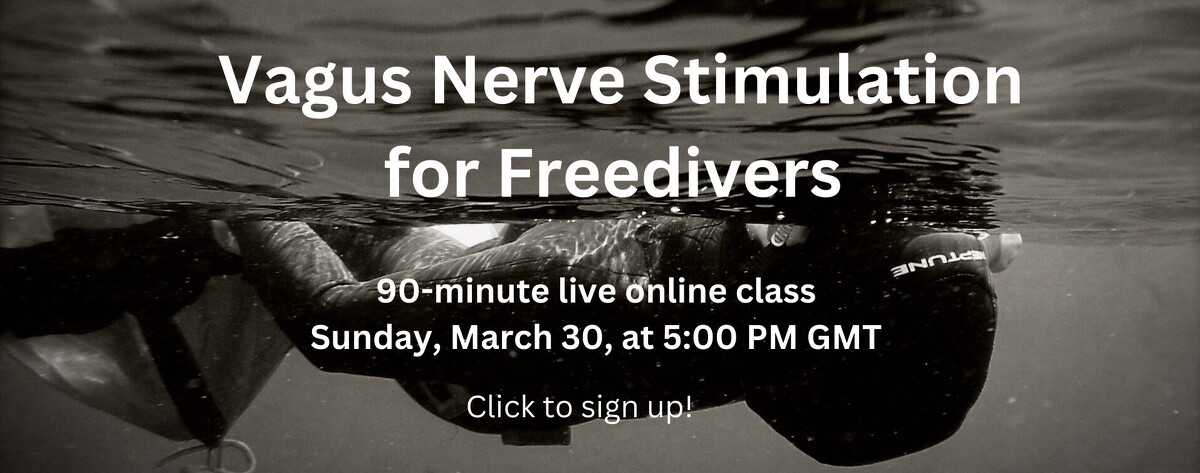I recently gave two presentations about vagus nerve stimulation for freedivers in Dahab, Egypt, at The Freedive Place and Molchanova Freediving School. One was in English, and the other in Russian; both events were firsts of their kind.

I talked about transcutaneous vagus nerve stimulation (tVNS) as a self-regulation and recovery method. I had two stimulators, and two people at a time could try it as soon as I spoke briefly about the tVNS and its side effects and contraindications. I continued talking in more detail about the vagus nerve itself and various aspects of its electrical stimulation. At the same time, the participants passed the devices to each other, having used them for about 20 minutes. I told them how to buy a stimulator, and answered their questions.
“It Was My Easiest Dive In Three Years”

The audience was very engaged. Participants shared their feedback. Those with a fitness watch checked their heart rate data. Some showed a significant stress reduction, while others showed their usual relaxation levels. The subjective feelings were also varying from enthusiastic to reserved.
Interestingly, the very first participants who volunteered to try stimulation at my first event did not report any notable changes in their state. But everyone else who tried it after them said they felt very relaxed and rested and showed their heart rate data. Then the first two decided to try again after everyone else and both reported significant relaxation and a decrease in chronic muscle pain which was also consistent with the research.
Two of the participants in that first presentation sent me screenshots of their readings from heart-monitoring apps. One of them pointed out the decrease in heart rate which was more pronounced than usual according to him. That participant held his breath during the stimulation. The other did not hold her breath, and her heart rate did not change as much, but her stress level decreased greatly. Her app calculates it somehow.


It turned out that one person went diving on the second day after the presentation. They allowed me to share their impression of the first training session after stimulation: “It was my easiest dive in three years”.
tVNS Effects Of Interest To Freedivers
That was the first and so far the only feedback I received from a freediver not immediately after stimulation but after the following training session. I believe this may be the most likely and pronounced benefit of vagus nerve stimulation for freedivers: accelerated and more efficient recovery.
It appears to be the most studied tVNS effect in connection to sports. In 2023 in Turkey, they investigated the effects of tVNS on recovery after cycling; 90 people took part in the experiment. The results showed that stimulation was effective in reducing fatigue and pain after training. The powerful restorative effect of stimulation is confirmed in other areas of its application.
tVNS may have an even more significant effect on training in freediving than other sports. It is the vagus nerve that triggers the activation of the mammalian diving response. It also facilitates a physiological state of relaxation.
Here are some established psychophysiological effects of tVNS that can have a positive impact on freedivers' training:
- slowed heart rate
- increased heart rate variability (the adaptability of the cardiovascular and nervous systems)
- increased lung capacity
- muscle relaxation and improved flexibility
- improved focus and self-regulation
- enhanced neuroplasticity/learning (i.e. adaptation)
- accelerated recovery
Moreover, the vagus nerve supplies nerve fibres to the soft palate, root of the tongue and epiglottis. It helps us coordinate breathing, swallowing and speech. Combined with training, tVNS may improve the motor control of the pharynx and hence enhance the equalisation skill.

The immediate effects of a single stimulation for freedivers have yet to be explored, and I hope this will happen soon. tVNS is still a novel method, and its research in sports has only just begun in recent years.
Its regular use during recovery seems the most plausible application in freediving. This way, tVNS can indirectly influence subsequent training, helping to achieve better fitness and prevent injuries associated with lack of recovery. Importantly, tVNS can serve freedivers as an effective overtraining prevention and recovery tool.
<UPD summer 2025: I have already found some evidence of tVNS used for 7 days improving cardiorespiratory fitness while attenuating inflammation>
To Be Continued
In my presentations, I talked about how to do tVNS and what effects to expect, after a single stimulation and with regular use. I mentioned different areas of application of this method and advised how and where to buy equipment for tVNS. To demonstrate what links freediving, self-regulation and the vagus nerve, I shared some information on anatomy and physiology in simple terms. It was evident that this information was of interest to freedivers while not particularly widely known. I think there will be a demand for courses and materials on that.
Curiously, the attendees of my second presentation seemed more interested in tVNS applications “for normal life” rather than for freediving training. It was also discussed a lot at the first event. The restorative and stress-reducing effects of tVNS fascinate me too. I have started a few interesting conversations about it which I would like to continue.

There was a medical doctor in the audience, and he started a discussion comparing tVNS with HRV training. We didn’t have enough time to expand that conversation, and I keep thinking about it and researching it. For those not familiar with HRV training, I described it in my free guide “Relaxation Training after Trauma”. By the way, the doctor at the presentation said he liked the guide a lot!
<UPD: To answer that doctor's question, I found evidence that slow breathing does increase HRV more than tVNS acutely. However, in the long term, tVNS improves this parameter significantly while having other notable benefits.>
While advertising my presentations and reporting on them, I received quite a lot of comments. Many wished to attend an online event on tVNS in connection to freediving. I am working on organising such an event.

freediving instructor, psychologist, physics teacher
I also give private sessions teaching to use vagus nerve stimulation
+79225441082 (WhatsApp/Telegram)
References
Özden, A. V., Alptekin, H. K., Pehlivanoğlu, B. E., & Ünal, M. (2024). A new method for sportive performance and recovery: Auricular vagus nerve stimulation (Review). BAU Journal of Health and Information, 2(1), Article 3. https://jag.journalagent.com/bauhi/pdfs/BAUH-98608-REVIEW-OZDEN.pdf
Hatik, S. H., Asrlan, M., Demirbilek, Ö., & Özden, A. V. (2023). The effect of transcutaneous auricular vagus nerve stimulation on cycling ergometry and recovery in healthy young individuals. Brain and Behavior, 13(12), e3332. https://doi.org/10.1002/brb3.3332
Lindley, K. (2019). Effect of Transcutaneous Vagus Nerve Stimulation on Sports Performance. ProQuest Dissertations & Theses, Arizona State University. Lindley_asu_0010N_18920.pdf
Güçlüer, E. Ö., Ural, İ. H., Özden, A. V., Alptekin, H. K., & Hatık, S. H. (2024). Effects of Auricular Vagus Nerve Stimulation on Cardio-Respiratory Functions After Aerobic Exercise. International Journal of Disabilities Sports and Health Sciences, 7(3), 494-501. https://doi.org/10.33438/ijdshs.1406505
De Couck, M., Cserjesi, R., Caers, R., Zijlstra, W., Widjaja, D., Wolf, N., Luminet, O., Ellrich, J., & Gidron, Y. (2017). Effects of short and prolonged transcutaneous vagus nerve stimulation on heart rate variability in healthy subjects. Autonomic Neuroscience, 203, 88-96. https://doi.org/10.1016/j.autneu.2016.11.003
Geng, D., Liu, X., Wang, Y., & Wang, J. (2022). The effect of transcutaneous auricular vagus nerve stimulation on HRV in healthy young people. PLOS ONE, 17(2), e0263833. https://doi.org/10.1371/journal.pone.0263833
Clancy, J. A., Mary, D. A., Witte, K. K., Greenwood, J. P., Deuchars, S. A., & Deuchars, J. (2014). Non-invasive Vagus Nerve Stimulation in Healthy Humans Reduces Sympathetic Nerve Activity. Brain Stimulation, 7(6), 871-877. https://doi.org/10.1016/j.brs.2014.07.031
Tischer, J., Szeles, J. C., & Kaniusas, E. (2025). Personalized auricular vagus nerve stimulation: Beat-to-beat deceleration dominates in systole-gated stimulation during inspiration - a pilot study. Frontiers in Physiology, 15, 1495868. https://doi.org/10.3389/fphys.2024.1495868

авторизуйтесь